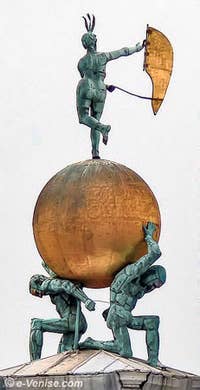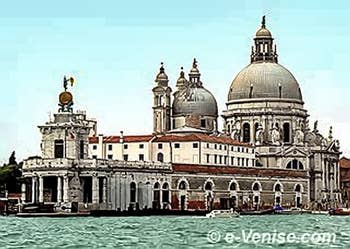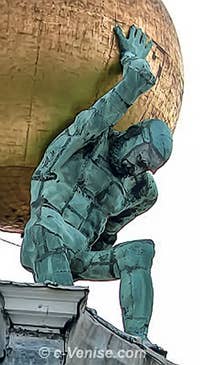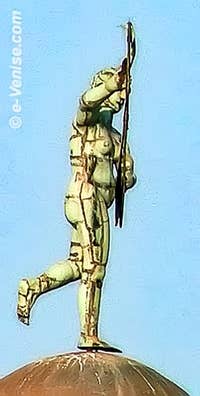Squares Arsenal | Hunchback | Dogana | Colleoni | Rioba | Piazzetta St. Mark | Stefano | Rialto Vecchio
The Dogana da Mar (Venice Sea Customs), its Fortune and its Atlanteans

Fortune and the Atlanteans The Dogana da Mar, or Sea Customs, is a sight to behold for all visitors to Venice, magnificently positioned in front of the Church of La Salute, at the tip of the Zattere.
Originally, Venice's general customs office was located in Castello, next to the entrance to the Arsenal.
But in 14 it was found that this customs office was no longer sufficient to handle the increasing amount of goods arriving in Venice.
It was then decided not only to move the customs services but also to split them into land customs and sea customs.
The land customs post was set up on Riva del Vin at Rialto, while the sea customs post, responsible for purely maritime trade, was set up at the tip of Dorsoduro, opposite St. Mark and the Bacino de San Marco, where much of the maritime traffic arrived at the time.
Because this end of the District in Dorsoduro was shaped like a "spike", triangular warehouses were built to receive goods for customs clearance. These warehouses were first rebuilt in 1525, only to be completely rebuilt again in 1677.
In fact, in the meantime, just behind the Dogana da Mar, the Church of the Salute, a magnificent Baroque work by the architect Baldassare Longhena, was nearing completion.

Red gondola in front of the Dogana da Mar For aesthetic reasons, it was decided to rebuild a new sea customs house in harmony with the architecture of the new church.
A competition was launched, in which Longhena of course took part, anxious to preserve the architectural perspective of his church, as well as another architect, then unknown in Venice, Giuseppe Benoni.
The vote between the two projects was close, with Benoni's project winning by only 6 votes to 5. It is true that Longhena's project was extremely sober so as not to overshadow his Salute, whereas Benoni did not have the same concern and therefore proposed a more original project.
On the colonnaded loggia at the end of the Dogana da Mar, he planned to place a group of bronze statues. Two Atlanteans would carry a globe on their backs, with Lady Fortune at the top.
This gilded ensemble was also intended to serve as a lighthouse for boats entering the Bacino San Marco.
A final touch of originality, dear Fortune would turn with the wind and, as this was the Dogana da Mar, it was of course the sail she held at the end of her hands that helped her in her role as a weathervane with a nimble foot, just like the golden angel at the top of St. Mark's Campanile, which also rotates according to the direction of the wind.
The bronze sculptures of the Atlanteans and Fortune were made by Bernardo Falcone and the whole complex, buildings and sculptures were completed in 1677.
The Dogana da Mar and its pretty, whirling Fortune inspired many writers:
A tongue of land
“We had retraced our steps along the Zattere; we crossed new campi, bridges and alleyways as far as the Salute.
There we walked to the tip of the Dogana di mar, on the narrow quay, if the name of quay can be given to the slabs and steps supported on stilts and used for loading and unloading the gondolas at the foot of the monuments lining the Grand Canal.
I lean for a moment against the tall bronze lantern that stands on the last strip of land of the Dogana di mar: a huge gas spout sparkles in the windows of this lantern, which illuminates my right and releases into the air the masts, rigging, sails and flags of the ships at anchor awaiting a visit from customs at the entrance to the Giudecca canal.
On the other bank the Piazzetta, the Libreria vecchia and the Ducal Palace appear to me in a new aspect; I see them resounding with the glorious celebrations that a future will return to them!”
Louise Colet - L'Italie des italiens 1862
La Renommée: Slender foot, outstretched wings

The Atlantes
“All the details of the sculptures stand out in relief: the bronze Renommée from the Dogana di mare, slender foot, wings outstretched, rushes from her golden ball into the ether!
What a caressing and good morning!
How it penetrates me, embraces me, holds me and cries out to me to the depths of my heart: “Don't go!!” Never has Venice seemed so beautiful!”
Louise Colet - L'Italie des italiens 1862
“To the lively wind of the lagoon,
That turns it to his will,
I have seen your fortune turn,
O Dogana di Mare;”
Henri de Régnier - Venetian sketches
Extract from Poem “Frontispiece”
“I love you, O Zattere, for all your luminous or nocturnal length, from the tip of the Dogana where you begin to the Calle del Vento where your stone quay ends, lined with various facades!
The Fortune I love you in all your expanse because, on your pavement, it's good to walk fast or slow or stop, depending on the time and the season, in the shade or in the sun, O Zattere!”
Henri de Régnier - Venetian sketches
Extract from a letter to Madame la Comtesse Mathieu de Noailles
“For it is in this quarter of Venice, whose triangle, closed by the rio San Trovaso, bears at its point the Dogana di Mare and its golden Fortune that sails in the wind, between the Zattere and the Grand Canal, it is in this quarter, so melancholy and so solitary, where the Badia hides its damp and charming cloister, where the poor church of Santa Agnese shows its big, jangling bell uncovered in its little campanile.
There, between Campiello Barbaro and Campo San Vio, on the Fondamente Venier, is the house where I live, - where I live, happier than a Doge.”
Henri de Régnier - Venetian sketches
“Turning towards the back of the Piazza, the perspective looks like this: the continuation of the Giudecca, the Dogana with its dishevelled Fortune, whose ball, which is being redone, gleams with a brand new shine.”
Théophile Gautier - Italia 1855

La Dogana da Mar and the church of La Salute
“La Dogana di Mare juts proudly out into the sea. Its columns, statues and golden globe gleaming in the sunlight gloriously open the entrance to the Grand Canal.”
Henry Havard - Amsterdam and Venice 1876
“At the end of the Grand Canal, and towards the port of Venice proper, rises the Dogana.
This immense edifice has a beautiful marble colonnade supporting a tower above which is placed a bronze globe carried by several figures; this globe is itself surmounted by a statue of Fortune which turns as a weather vane: an ingenious emblem of the fortunes and vicissitudes of commerce.”
Jules-Léonard Belin - Le Simplon 1843

Detail of an Atlantean
“The charming architectural promontory of the Dogana carrying between its arms and hands a gilded globe on which turns the ravishing and mocking silhouette of a female weathervane.
This Fortune, this lighthouse, or whatever other name she may have -- indeed she needs no name -- catches the wind in a piece of drapery that she has removed from her swirling bronze beauty.”
Henry James - Italian Hours
“At the end of the promontory, the Dogana di Mare carries aloft, on a globe supported by two Atlases, a golden Fortune, revolving like a lighthouse.”
Matthieu Pol-Anatole 1901
“A highly original monument this Dogana di mare, built at the end of the 17th century in a style that is both rich and severe, and surmounted by a colossal Fortune who, with one foot placed on the globe of the world, turns in every wind, to show business people how great is the inconstancy of the goddess they worship.”
René Kerviler - Thirty days through Savoy, Switzerland and Italy 1893
Squares Arsenal | Hunchback | Dogana | Colleoni | Rioba | Piazzetta St. Mark | Stefano | Rialto Vecchio
Back to Top of Page


